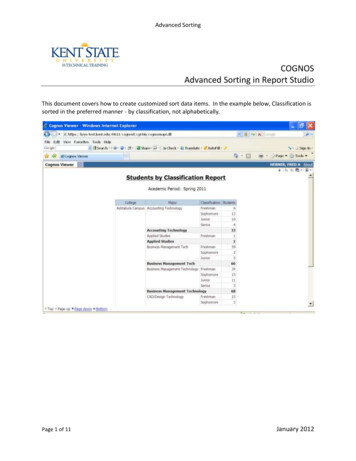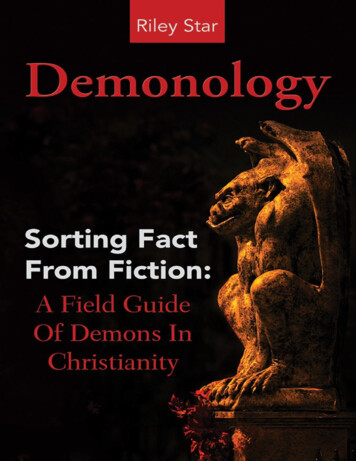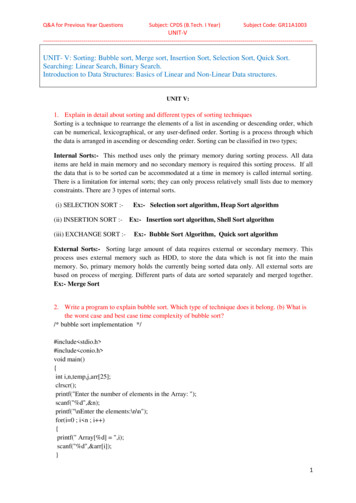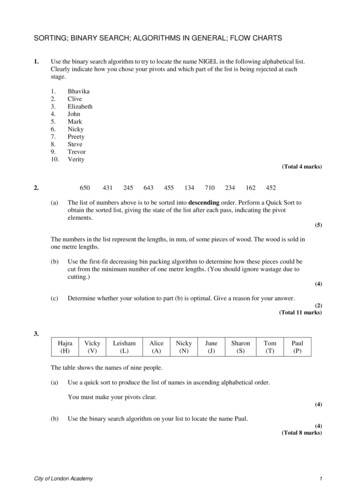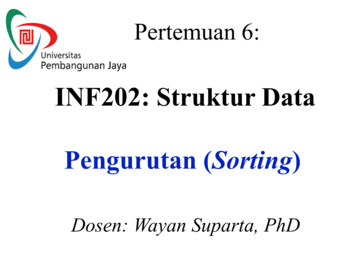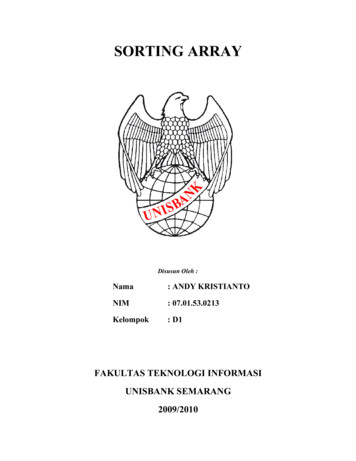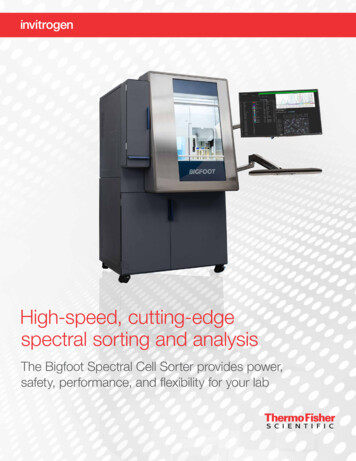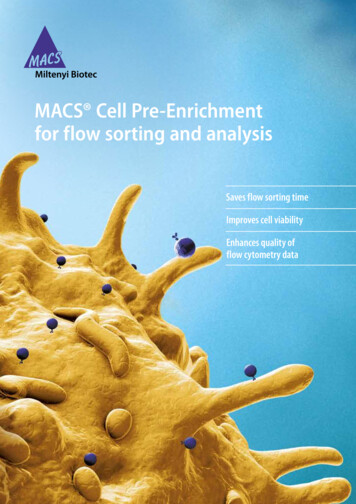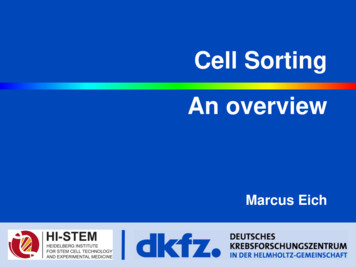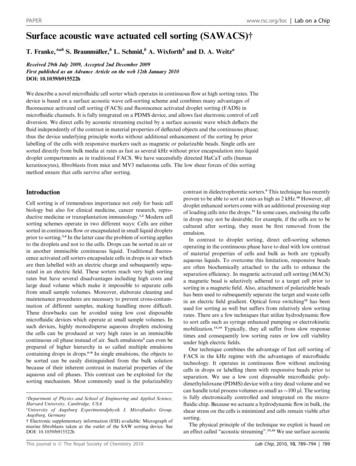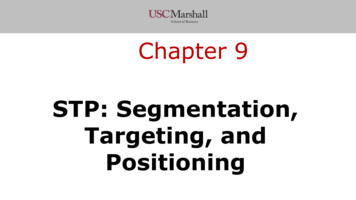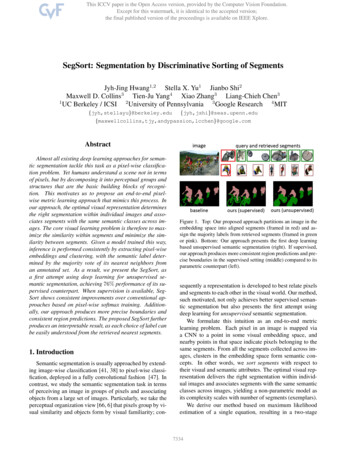
Transcription
SegSort: Segmentation by Discriminative Sorting of SegmentsJyh-Jing Hwang1,2 Stella X. Yu1 Jianbo Shi2Maxwell D. Collins3 Tien-Ju Yang4 Xiao Zhang3 Liang-Chieh Chen31UC Berkeley / ICSI 2 University of Pennsylvania 3 Google Research 4 e.comAbstractAlmost all existing deep learning approaches for semantic segmentation tackle this task as a pixel-wise classification problem. Yet humans understand a scene not in termsof pixels, but by decomposing it into perceptual groups andstructures that are the basic building blocks of recognition. This motivates us to propose an end-to-end pixelwise metric learning approach that mimics this process. Inour approach, the optimal visual representation determinesthe right segmentation within individual images and associates segments with the same semantic classes across images. The core visual learning problem is therefore to maximize the similarity within segments and minimize the similarity between segments. Given a model trained this way,inference is performed consistently by extracting pixel-wiseembeddings and clustering, with the semantic label determined by the majority vote of its nearest neighbors froman annotated set. As a result, we present the SegSort, asa first attempt using deep learning for unsupervised semantic segmentation, achieving 76% performance of its supervised counterpart. When supervision is available, SegSort shows consistent improvements over conventional approaches based on pixel-wise softmax training. Additionally, our approach produces more precise boundaries andconsistent region predictions. The proposed SegSort furtherproduces an interpretable result, as each choice of label canbe easily understood from the retrieved nearest segments.1. IntroductionSemantic segmentation is usually approached by extending image-wise classification [41, 38] to pixel-wise classification, deployed in a fully convolutional fashion [47]. Incontrast, we study the semantic segmentation task in termsof perceiving an image in groups of pixels and associatingobjects from a large set of images. Particularly, we take theperceptual organization view [66, 6] that pixels group by visual similarity and objects form by visual familiarity; con-Figure 1. Top: Our proposed approach partitions an image in theembedding space into aligned segments (framed in red) and assign the majority labels from retrieved segments (framed in greenor pink). Bottom: Our approach presents the first deep learningbased unsupervised semantic segmentation (right). If supervised,our approach produces more consistent region predictions and precise boundaries in the supervised setting (middle) compared to itsparametric counterpart (left).sequently a representation is developed to best relate pixelsand segments to each other in the visual world. Our method,such motivated, not only achieves better supervised semantic segmentation but also presents the first attempt usingdeep learning for unsupervised semantic segmentation.We formulate this intuition as an end-to-end metriclearning problem. Each pixel in an image is mapped viaa CNN to a point in some visual embedding space, andnearby points in that space indicate pixels belonging to thesame segments. From all the segments collected across images, clusters in the embedding space form semantic concepts. In other words, we sort segments with respect totheir visual and semantic attributes. The optimal visual representation delivers the right segmentation within individual images and associates segments with the same semanticclasses across images, yielding a non-parametric model asits complexity scales with number of segments (exemplars).We derive our method based on maximum likelihoodestimation of a single equation, resulting in a two-stage7334
Expectation-Maximization (EM) framework. The first stageperforms a spherical (von Mises-Fisher) K-Means clustering [4] for image segmentation. The second stage adaptsthe E-step for a pixel-to-segment loss to optimize the metric learning CNN.As a result, we present the SegSort (Segment Sorting)as a first attempt to apply deep learning for semantic segmentation from the unsupervised perspective. Specifically,we create pseudo segmentation masks aligned with visualcues using a contour detector [2, 32, 73] and train the pixelwise embedding network to separate all the segments. Theunsupervised SegSort achieves 76% performance of its supervised counterpart. We further show that various visualgroups are automatically discovered in our framework.When supervision is available (i.e., supervised semantic segmentation), we segment each image with the spherical K-Means clustering and train the network followingthe same optimization, but incorporated with NeighborhoodComponents Analysis criterion [22, 71] for semantic labels.To summarize our major contributions:1. We present the first end-to-end trained non-parametricapproach for supervised semantic segmentation, withperformance exceeding its parametric counterparts thatare trained with pixel-wise softmax loss.2. We propose the first unsupervised deep learning approach for semantic segmentation, which achieves76% performance of its supervised counterpart.3. Our segmentation results can be easily understoodfrom retrieved nearest segments and readily interpretable.4. Our approach produces more precise boundaries andmore consistent region segmentations compared withparametric pixel-wise prediction approaches.5. We demonstrate the effectiveness of our method ontwo challenging datasets, PASCAL VOC 2012 [16]and Cityscapes [14].2. Related WorksSegmentation and Clustering. Segmentation involves extracting representations from local patches and clusteringthem based on different criteria, e.g., fitting mixture models [74, 5], mode-finding [13, 4], or graph partitioning[18, 62, 49, 64, 78]. The mode-finding algorithms, e.g.,mean shift [13] or K-Means [26, 4], are mostly related. Traditionally, pixels are encoded in a joint spatial-range domainby a single vector with their spatial coordinates and visualfeatures concatenated. Applying mean shift or K-Meansfiltering can thus converge for each pixel. Spectral graphtheory [12], and in particular the Normalized Cut [62] criterion provides a way to further integrate global image information for better segmentation. More recently, superpixelapproaches [1] emerge to be a popular pre-processing stepthat helps reduce the computation, or can be used to refinethe semantic segmentation predictions [20]. However, thechallenge of perceptual organization is to process information from different levels together to form consensus segmentation. Hence, our proposed approach aims to integrateimage segmentation and clustering into end-to-end embedding learning for semantic segmentation.Semantic Segmentation. Current state-of-the-art semantic segmentation models are based on Fully ConvolutionalNetworks [41, 61, 47], tackling the problem via pixelwise classification. Given limited local context, it maybe ambiguous to correctly classify a single pixel, and thusit is common to resort to multi-scale context information[28, 63, 36, 39, 23, 76, 51, 34, 31]. Typical approachesinclude image pyramids [17, 55, 15, 43, 10, 8] and encoderdecoder structures [3, 56, 42, 19, 54, 77, 79, 11]. Notably, to better capture multi-scale context, PSPNet [80]performs spatial pyramid pooling [24, 40, 46] at several gridscales, while DeepLab [8, 9, 75] applies the ASPP module(Atrous Spatial Pyramid Pooling) consisting of several parallel atrous convolution [30, 21, 61, 53] with different rates.In this work, we experiment with applying our proposedtraining algorithm to PSPNet and DeepLabv3 , and showconsistent improvements.Before deep learning takes a leap, non-parametric methods for semantic segmentation are explored. In the unsupervised setting, [57] proposes data-driven boundary andimage grouping, formulated with MRF to enhance semanticboundaries; [67] extracts superpixels before nearest neighbor search; [45] performs dense SIFT to find dense deformation fields between images to segment and recognize aquery image. With supervision, [50] learns semantic objectexemplars for detection and segmentation.It is worth noting Kong and Fowlkes [37] also integratevMF mean-shift clustering into the semantic segmentationpipeline. However, the clustering with contrastive loss isused for regularizing features and the whole system still relies on softmax loss to produce the final segmentation.Our work also bears a similarity to the work Scene Collaging [33], which presents a nonparametric scene grammarfor parsing the images into segments for which object labelsare retrieved from a large dataset of example images.Metric Learning. Metric learning approaches [35, 22] haveachieved remarkable performance on different vision tasks,such as image retrieval [70, 72, 71] and face recognition[65, 69, 60]. Such tasks usually involve open world recognition, since classes during testing might be disjoint from theones in the training set. Metric learning minimizes intraclass variations and maximizes inter-class variations withpairwise losses e.g., contrastive loss [7] and triplet loss [29].Recently, Wu et al. [72] propose a non-parametric softmaxformulation for training feature embeddings to separate every image for unsupervised image recognition and retrieval.7335
Figure 2. The overall training diagram for our proposed framework, Segment Sorting (SegSort), with the vMF clustering [4]. Given a batchof images (leftmost), we compute pixel-wise embeddings (middle left) from a metric learning segmentation network. Then we segmenteach image with the vMF clustering (middle right), dubbed pixel sorting. We train the network via the maximum likelihood estimationderived from a mixture of vMF distributions, dubbed segment sorting. In between, we also illustrate how to process pixel-wise features ona hyper-sphere for pixel and segment sorting. A segment (rightmost) is color-framed with its corresponding vMF clustering color if in thedisplayed images. Unframed segments from different images are associated in the embedding space. The inference is done with the sameprocedure but using the k-nearest neighbor search to associate segments in the training set.The non-parametric softmax is further incorporated withNeighborhood Components Analysis [22] to improve generalization for supervised image recognition [71]. An important technical point on metric learning is normalization[68, 60] so that features lie on a hypersphere, which is whythe vMF distribution is of particular interest.3. MethodOur end-to-end learning framework consists of threesequential components: 1) A CNN, e.g., DeepLab [11],FCN [47], or PSPNet [80], that generates pixel-wise embeddings from an image. 2) A clustering method that partitions the pixel-wise embeddings into a fine segmentation,dubbed pixel sorting. 3) A metric learning formulation forseparating and grouping the segments into semantic clusters, dubbed segment sorting.We start with an assumption that the pixel-wise normalized embeddings from the CNN within a segment follow avon Mises-Fisher (vMF) distribution. We thus formulate thepixel sorting with spherical K-Means clustering and the segment sorting with corresponding maximum likelihood estimation. During inference, the segment sorting is replacedwith k-nearest neighbor search. We then apply to eachquery segment the majority label of retrieved segments.We now give a high level mathematical explanation ofthe entire optimization process. Let V {vv i } {φ(xi )}be the set of pixel embeddings where v i is produced by aCNN φ centered at pixel xi . Let Z {zi } be the imagesegmentation with k segments, or zi s indicates if a pixeli belongs to a segment s. Let Θ {θzi } be the set of parameters that capture the representative feature of a segmentthrough a predefined distribution f (mixture of vMF here).Our main optimization objective can be concluded as:X1log fzi (vv i θzi ).ki(1)In pixel sorting, we use a standard EM framework to findthe optimal Z and Θ, with φ fixed. In segment sorting, weadapt the previous E step for loss calculation through a setof images to optimize φ, with Z and Θ fixed. Performingpixel sorting and segment sorting can thus be viewed as atwo-stage EM framework.This section is organized as follows. We first describe thepixel sorting in Sec. 3.1, which includes a brief review ofspherical K-Means clustering and creation of aligned segments. We then derive two forms of the segment sortingloss for segment sorting in Sec. 3.2. Finally, we describethe inference procedure in Sec. 3.3. The overall training diagram is illustrated in Fig. 2 and the summarized algorithmcan be found in the supplementary.min log P (V, Z Θ) min φ,Z,Θφ,Z,Θ3.1. Pixel SortingWe briefly review the vMF distribution and its corresponding spherical K-Means clustering algorithm [4],which is used to segment an image as pixel sorting.We assume the pixel-wise d-dimensional embeddingsv Sd 1 (CNN’s last layer features after normalization)within a segment follow a vMF distribution. vMF distributions are of particular interest as it is one of the simplestdistributions with properties analogous to those of the multivariate Gaussian for directional data. Its probability density function is given byµ v ),f (vv µ , κ) Cd (κ) exp(κµ7336(2)
d/2 1κis the normalizing constantwhere Cd (κ) (2π)d/2Id/2 1 (κ)where Ir (·) represents the modifiedBesselP function of thePv/ first kind and order r. µ ii v i is the meanidirection and κ 0 is the concentration parameter. Largerκ indicates stronger concentration about µ. In our particularcase, we assume a constant κ for all vMF distributions tocircumvent the expensive calculation of Cd (κ).The embeddings of an image with k segments can thusbe considered as a mixture of k vMF distributions with auniform prior, orf (vv Θ) kX1fs (vv µ s , κ),ks 1(3)µ1 , · · · , µk , κ}. Let zi be the hidden variablewhere Θ {µthat indicates a pixel embedding v i belongs to a particularsegment s, or zi s. Let V {vv 1 , · · · , v k } be the setof pixel embeddings and Z {z1 , · · · , zk } be the set ofcorresponding hidden variables. The log-likelihood of theobserved data is thus given bylog P (V, Z Θ) Xi1log fzi (vv i µ zi , κ).k(4)Since Z is unknown, the EM framework is used to estimate this otherwise intractable maximum likelihood, resulting in the spherical K-Means algorithm with an assumptionof κ 7 . This assumption holds if all the embeddingswithin a region are the same (homogeneous), which will beour training objective described in Sec. 3.2.The E-step that maximizes the likelihood of Eqn. 4 is toassign zi s with a posterior probability [52]:fs (vv i Θ)p(zi s vv i , Θ) Pk.v l Θ)l 1 fl (vFigure 3. During supervised training, we partition the proposedsegments (left) given the ground truth mask (middle). The yieldedsegments (right) are thus aligned with ground truth mask. Eachaligned segment is labeled (0 or 1) according to ground truthmask. Note that the purple and yellow segments become, respectively, false positive and false negative that help regularize predicted boundaries.(5)In the setting of K-Means, we use hard assignments toupdate zi , or zi argmaxs p(zi s v i , Θ) argmaxs µ s v i . We further denote the set of pixels within asegment c as Rc ; hence p(zi c v i , Θ) 1 if i Rc or0 otherwise after hard assignments.The M-step that maximizes the expectation of Eqn. 4 canbe derived [4] asPPvii v i p(zi c v i , Θ)Pµc µ̂, (6) Pi Rc i v i p(zi c v i , Θ) i Rc v i which is the mean direction of pixel embeddings withinsegment c. The spherical K-Means clustering is thus donethrough alternating updates of Z (E-step) and Θ (M-step).One problem of K-Means clustering is the dynamic number of EM steps, which would cause uncertain memory consumption during training. However, we find in practice asmall fixed number of EM steps, i.e., 10 iterations, can already produce good segmentations.If we only use embedding features for K-Means clustering, each resulted cluster is often disconnected andscattered. As our goal is to spatially segment an image, weconcatenate pixel coordinates with the embeddings so thatthe K-Means clustering is guided by spatiality.Creating Aligned Segments. Segments that are alignedwith different visual cues are critical for producing coherent boundaries. However, segments produced by K-Meansclustering do not always conform to the ground truth boundaries. If one segment contains different semantic labels, itclearly contradicts our assumption of homogeneous embeddings within a segment. Therefore, we partition a segmentgiven the ground truth mask in the supervised setting so thateach segment contains exactly a single semantic label as illustrated in Fig. 3.It is easy to see that the segments after partition are always aligned with semantic boundaries. Furthermore, thispartition creates small segments of false positives and falsenegatives which can naturally serve as hard negative examples during loss calculation.3.2. Segment SortingFollowing our assumption of homogeneous embeddingsper segment, the training is therefore to enforce this criterion, which is done by optimizing the CNN parameters forbetter feature extraction.We first define a prototype as the most representative embedding feature of a segment. Since the embeddings in asegment follow a vMF distribution, the mean direction vector µ c in Eqn. 6 can naturally be used as the prototype.In Sec. 3.1, we consider the posterior probability of apixel embedding v i belonging to a segment s with fixedCNN parameters in Eqn. 5. Now we revisit it with free CNNparameters φ and a constant hyperparameter κ:µ exp(κµfs (vv i Θ)s v i) Pk.pφ (zi s v i , Θ) Pkvµ l 1 fl (v l Θ)l 1 exp(κµl vi)(7)As both the embedding v and prototype µ are of unit length,7337
µthe dot product v µ vvv µµ becomes the cosine similarity. The numerator indicates the exponential cosine similarity between a pixel embedding v i and a particular segmentprototype µ s . The denominator includes the exponential cosine similarities w.r.t. all the segment prototypes. The valueof pφ indicates the ratio of pixel embedding v i close to segment s compared to all the other segments.The training objective is thus to maximize the posteriorprobability of a pixel embedding belonging to its corresponding segment c obtained from the K-Means clustering.In other words, we want to minimize the following negativelog-likelihood, or the vMF loss:classified by associating the right neighbor prototypes. Theground truth labels are thus used for finding the set of sameclass segments Ci w.r.t. pixel i within a mini-batch (andmemory banks). If there is no other segment in the samecategory, we fall back to the previous vMF loss. Since bothvMF and vMF-N losses serve the same purpose for grouping and separating segments by optimizing the CNN featureextraction, we dub them segment sorting losses.Understandably, an essential component of the segmentsorting loss is the existence of semantic neighbor segments(in the numerator) and the abundance of alien segments (inthe denominator). That is, the more examples presentedat once, the better the optimization. We thus leverage twostrategies: 1) We calculate the loss w.r.t. all the segments inthe batch as opposed to traditionally image-wise loss function. 2) We use additional memory banks that cache thesegment prototypes from previous batches. In our experiments, we cache up to 2 batches. These two strategies helpthe fragmented segments (produced by segment partition inFig. 3) connect to other similar segments between differentimages, or even between different batches.µ exp(κµc v i).LivMF log pφ (c v i , Θ) log Pkµ l 1 exp(κµl v i)(8)The total loss is the average over all pixels. As a result,minimizing LvMF has two effects: One i
beddings from an image. 2) A clustering method that par-titions the pixel-wise embeddings into a fine segmentation, dubbed pixel sorting. 3) A metric learning formulation for separating and grouping the segments into semantic clus-ters, dubbed segment sorting. We s
